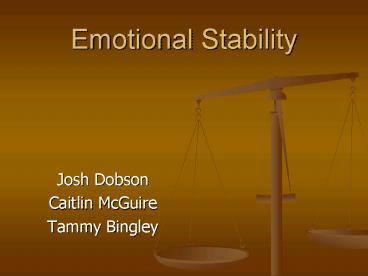Emotional Stability - PowerPoint PPT Presentation
1 / 11
Title:
Emotional Stability
Description:
Emotional Stability. Josh Dobson. Caitlin McGuire. Tammy Bingley. Previous Research. Summary 1: Study which examined links among sex, personality, and expectations for ... – PowerPoint PPT presentation
Number of Views:1795
Avg rating:3.0/5.0
Title: Emotional Stability
1
Emotional Stability
- Josh Dobson
- Caitlin McGuire
- Tammy Bingley
2
Previous Research
- Summary 1
- Study which examined links among sex,
personality, and expectations for emotional
events and found a relation between agreeableness
and expectations for reactions to positive and
negative emotionally evocative material. Study 2
participants described contents of emotionally
evocative slides to a partner (either friend or
stranger) and indicated that agreeableness and
sex were significant predictors of emotional
experience and of efforts to control emotion
(Tobin et al, 2000). - Summary 2
- There have been many studies performed to find
the relationship between personality traits
emotional stability and anxiousness. Berrien
(1993) did a study that tested the relationship
between emotionally stable and unstable persons
and their dreams. His theory was that persons who
were emotionally unstable recalled more dreams or
dream fragments than emotionally stable persons.
3
Emotional Stability
- By Definition
- ? a mental state of calmness and
composure. - In reference to our scale HIGH scorers are
generally more sensitive, emotional and prone to
feelings that are upsetting, such as guilt or
sadness. LOW scorers are emotionally secure,
resistant and relaxed individuals even under very
stressful conditions.
4
Purpose
- There has been previous work done on the topic of
emotional stability. This is partially because
it is an important personality trait that is part
of the Big 5 Theory. The purpose of our study is
to design a scale that will test a participants
emotional stability. In order to make sure we
are testing for emotional stability we will have
an anxiousness scale for convergent validity and
an interpersonal trust scale for discriminant
validity, both having been used for previous
professional research.
5
Hypothesis
- We have devised a 15-item scale and believe that
it will test participants Emotional Stability.
In order to make sure that it does measure what
we want it to we are using an anxiousness scale
for convergent validity and an interpersonal
trust scale for discriminant validity.
6
Emotional Stability Scale
- Based on the questions below fill in the blanks
with the answer you believe best suits you, using
the following scale - 1- Always, 2- Often, 3- Sometimes,
4- Rarely, 5- Never - 1. _____ I have no confidence in myself. (R)
- 2. _____ I am a determined person.
- 3. _____ I never get upset when menial tasks
go poorly. - 4. _____ I believe that I control my future.
- 5. _____ I do not second guess myself.
- 6. _____ I believe that I am in control in
high stress situations - 7. _____ I fear judgment from others when
giving my opinions. (R) - 8. _____ I get distracted easily (R)
- 9. _____ I agree with others opinions just
to fit in. (R) - 10. _____ I am an independent individual.
- 11. _____ I have goals to accomplish and do not
let road blocks deter me. - 12. _____ I am always a happy person.
- 13. _____ I fear expressing my emotions. (R)
- 14. _____ I am able to adjust to changes in
plans - 15._____ I always sweat the small stuff. (R)
7
Convergent Validity
- For Convergent Validity we chose to use the
Interaction Anxiousness Scale by Leary (1983). - It is a 5 point Likert scale including 15
questions. - This scale is used to measure social anxiety.
- We chose this scale for our convergent validity
because we believe that anxiousness should have a
high negative correlation with emotional
stability, as its related to experiencing
negative emotions. We believe that people who are
emotionally stable are less likely to experience
negative emotions.
8
Discriminant Validity
- For discriminant validity we chose to use the
Interpersonal Trust Scale by Rotter (1967, 1971). - It is a 5 point likert scale including 25
questions. - This scale is designed to measure ones
expectation that the behavior, promises, or
(verbal or written) statements of other
individuals can be relied upon. - Our reason for choosing an interpersonal trust
scale is that it should provide discriminant
validity because it is not related to emotional
stability. We want to show our test measures
emotional stability, not just a measure of how
trust might affect emotions. - We expected to find a low correlation between our
discriminant variable and emotional stability.
9
Cronbachs Alpha
- ESS Cronbachs Alpha - .748
- Interpersonal Trust - Cronbachs Alpha - .802
- Anxiousness Scale Cronbachs Alpha - .749
10
Analysis of Discriminant and Convergent Validity
- The correlation between our Emotional Stability
Scale and Interpersonal Trust Scale was not
significant at R -.081 - The correlation between our Emotional Stability
Scale and Anxiousness Scale was significant in a
2-tailed t-test, R -.661, p lt .01
11
Conclusion
- Our hypothesis was supported which means that
emotional stability and anxiousness are inversely
correlated. Trust has no relationship with
emotional stability which were proven by our
results. - In future research, wording should be more
simplistic. As we had questions from participants
regarding what words meant, ie. Hypocrisy,
judiciary and menial.































